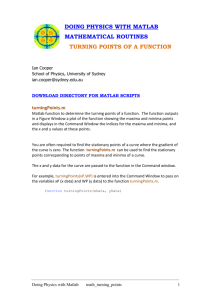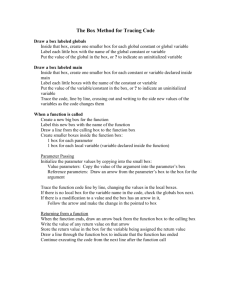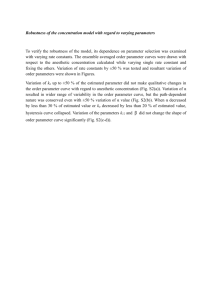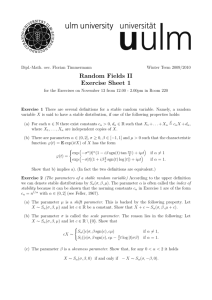An XML Data Model for Analytical Instruments
advertisement
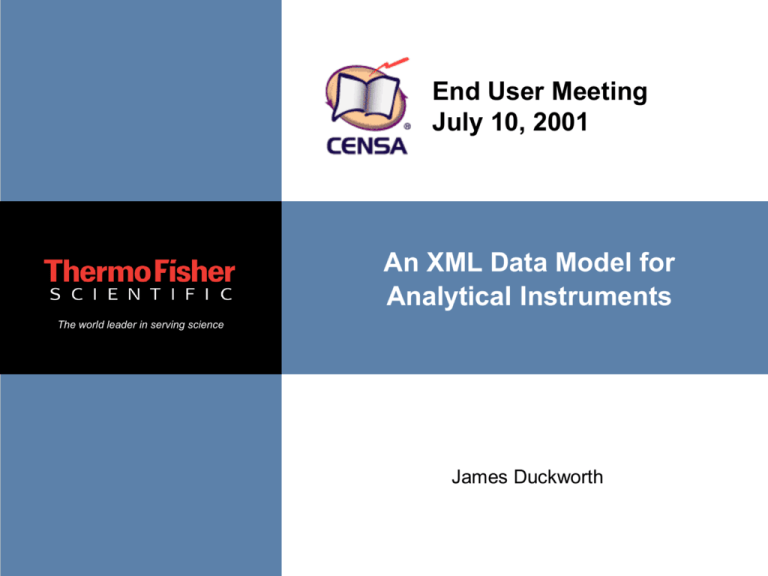
End User Meeting July 10, 2001 An XML Data Model for Analytical Instruments The world leader in serving science James Duckworth Analytical Data: A Tower of Babel MS 20 40 60 80 100 120 140 160 180 200 Mass (m/z) .5 LC 1 2.834 1.244 .863 1.927 .389 0 1.5 2 Minutes 2.5 3 3.5 IR NMR 12 11 10 9 8 7 6 5 4 3 2 Parts Per Million 4000 3500 3000 2500 2000 1500 1000 Wavenumber (cm-1) 1 0 2 Proprietary Analytical Data Formats Labs are heterogeneous mix of instrumentation and vendors Relevant data is not always stored in one file Data retention periods often longer than instrument and data system lifetimes Potentially requires keeping outdated software operational for a long time 3 Data Representations Increasing Transportability Original Raw Data Plots & Graphics Textual Results From Instrument Workstation Software GIF, HPGL, Metafiles, Scanned Printouts Peak Areas, Positions, Concentrations • Can be displayed with viewer software • Can be displayed with nearly anything (paper, word processor, etc.) • Full data and results • Can only be read by instrument workstation software • Eventual instrument obsolescence is a problem • Cannot reprocess, manipulate, or interact with the data • Totally disconnected from the raw data • Cannot compare data Increasing Information Content 4 FDA 21 CFR 11: Data Formats "The agency agrees that providing exact copies of electronic records in the strictest meaning of the word ''true'' may not always be feasible. The agency nonetheless believes it is vital that copies of electronic records provided to FDA be accurate and complete. Accordingly, in § 11.10(b), ''true'' has been replaced with ''accurate and complete.'' The agency expects that this revision should obviate the potential problems noted in the comments. The revision should also reduce the costs of providing copies by making clear that firms need not maintain obsolete equipment in order to make copies that are ''true'' with respect to format and computer system." 5 The Key To The Solution Translate and save in a neutral format • Must be both transportable and maintain information content • Enable data access from multiple applications • No need for obsolete hardware/software • Technology and IP from recent acquisitions of Galactic Industries Corp. and Thru-put Systems Inc. 6 Technology & IP Acquisitions Galactic Industries Corp. • Founded 1988, joined Thermo 2001 • GRAMS/32 Supports >150 spectroscopy file types UV, FT-IR, Raman, NMR, ICP, XRD/F Thruput Systems Inc. • Founded 1985, joined Thermo 1999 • Target/Target DB (HP Chemserver) Supports >50 chromatography file types GC, LC, MS, PDA Now part of the Thermo Scientific Informatics Division 7 Public-domain Data Formats in Use AnDI • Controlled by ASTM (E01.25) • MS & Chromatography only JCAMP • Controlled by IUPAC • Optical spectroscopy, NMR, MS SPC • Published by Galactic • Primarily optical spectroscopy 8 AnDI Format Binary data format maintains data precision • Uses “public-domain” netCDF software maintained by Unidata • Source code; must be compiled for each platform Technique-specific data templates • Chromatography (ASTM E 1947-98) • Mass Spectrometry (ASTM E 2077-00) 9 AnDI Chromatography Format Data Element Name peak-number peak-processing-resultstable-name peak-processing-resultscomments peak-processing-methodname peak-processing-datetime-stamp peak-retention-time peak-name peak-amount peak-amount-unit peak-start-time peak-end-time peak-width Datatype dimension string Category C2 C3 Required M2 . . . string C2 . . . string C2 . . . string C2 . . . floating-pointarray string-array floating-pointarray string floating-pointarray floating-pointarray floating-pointarray C2 M2 C3 C2 . . . M3 C2 C2 M3 . . . C2 . . . C2 . . . . . 10 JCAMP Format Completely ASCII-based • Simplifies transport and readability Fixed dictionary of tags • Required tags for core information • Custom tags allowed for private data Published and maintained by IUPAC 11 JCAMP Format for FTIR ##TITLE=Polystyrene run as a film ##JCAMP-DX=4.24 $$ Nicolet v. 100 ##DATATYPE=INFRARED SPECTRUM ##ORIGIN= ##OWNER= ##DATE=92/06/29 ##TIME=12:57:07 ##XUNITS=1/CM ##YUNITS=TRANSMITTANCE ##FIRSTX=399.241364 ##LASTX=4000.128418 ##FIRSTY=0.965158 ##MAXX=4000.128418 ##MINX=399.241364 ##MAXY=0.965158 ##MINY=0.000001 ##XFACTOR=1.000000 ##YFACTOR=1.000000E-009 ##NPOINTS=1868 ##DELTAX=1.928702 ##XYDATA=(X++(Y..Y)) 399.241 965157760 958141120 955421056 956603520 964025088 963178240 410.814 963215040 958321536 954287616 947153536 942139520 931181504 . . 12 Limitations of Current Formats Complex data description dictionaries, yet still not “complete” Numerical accuracy (JCAMP) Not “human readable” (AnDI & SPC) Cannot be easily validated for correct formatting and content Not extensible for future changes in equipment and analysis methods 13 The XML Data Model Not a file format, but a data description language Can be used to represent any data structure Recently adopted XML Schema Definition (XSD) language provides strong data typing and syntax constraints Extensible by design 14 Benefits of XML for Analytical Data Data is “human readable” ASCII text Public domain standard managed by W3C Documents can be externally validated for content and syntax (DTD or Schema) Hierarchical constructs for implying data relationships Proliferation of public domain tools Safe bet to be around for quite a while 15 Analytical Data Model Design Goals Dictionary and hierarchy (Schema) must be compact and simple Make use of XML data types and hierarchies to mimic relationships in data sources Allow for future expansion Mind the file size, XML is all ASCII • It will compress nicely though… 16 An XML Terminology Primer Element • Represents a fundamental piece of data or hierarchical relationship Attribute • Describes a property of an Element Schema (XSD) • Document that defines the allowed Elements, Attributes and relationships DTD • Document Type Definitions; older form of a Schema 17 XML Data Representations Items that software need to “understand” must be fundamental elements • Data point values • Collect date/time stamp • Peak apex, baseline start/end Items that software only need for display and reporting can be generically represented • Peak area, height, skewness, etc. • Sample type, flow rate, “analyst shoe size” 18 Breaking Down Analytical Data There are fundamental units of information that must be represented in the schema • • • • • • Experiments (i.e. sequence lists) Detectors “Axes” (i.e. X, Y, Z, etc.) Data points Peaks (i.e. apex, baseline start/end) Parameters 19 Generalized Analytical Markup Language <experiment> <collectdate> <parameter> <trace> <coordinates> <values> <Xdata> <values> <altXdata> <Ydata> <values> <peaktable> <peak> <peakXvalue> <peakYvalue> <baseline> <startXvalue> <endXvalue> <startYvalue> <endYvalue> data from single instrument "run" date & time of measurements relevant instrument parameter data from a single detector coordinates for nD data (optional) data values array X axis descriptor data values array alternate X data descriptor (optional) Y axis descriptor data values array peak list descriptor (optional) individual peak descriptor peak location peak intensity baseline descriptor (optional) baseline values 20 Instrumental Analysis Identify instrument type via "technique" attribute • Allows applications to know how to present/process data <trace . <trace . <trace . <trace technique="CHROM" name="Chromatogram"> technique="PDA" name="PDA Spectra"> technique="NMR" name="13C NMR Spectrum"> technique="MS" name="Mass Spectra"> 21 Curve Data Points Store data with no loss of information • Values are encoded “base64Binary” type to preserve numerical precision • Predefined list of "unit" attributes • Use "label" attribute for descriptive string <Ydata label="Response" units="MILLIVOLTS"> <values byteorder="INTEL" format="FLOAT32" numvalues="3800"> 8hkHQTqRBkFitAZBus8GQULjBkG6zwZBcl4GQSKVBkGiVgZB4nUGQbJ9BkG6 UgZBcl4GQUJmBkEyPwZBOpEGQbJ9BkECxAZBOpEGQTqRBkHidQZBaokGQcIn . . </values> </Ydata> 22 A Few Notes on "units" Applications must know the basis of data measurement • Data comparison or mining may require a transformation (i.e. "seconds" vs. "minutes") Similar problem exists in business applications • Pricing/quantity (i.e. "gallons" vs. "liters") Current XML standards? Not yet… Solution: Fixed list of units taken from IUPAC standards and past experience • Extend schema to adopt whatever W3C standard emerges in the future 23 Parameters Avoid the “mapping” problem; all are stored using a single element type • • • • Allowed to appear anywhere in hierarchy The optional "group" attribute assigns class The "name" attribute assigns identity Use optional "label" attribute for descriptive string <parameter group="inject" name="Inj Vol">6.00 ul</parameter> <parameter group="inject" name="Dilution">2.5000</parameter> <parameter group="inject" name="Position" >B124</parameter> <parameter group="instrument" name="Flow Rate" >1.5 ml/min</parameter> <parameter group="instrument" name="Column Temp" >27.5 C</parameter> <parameter group="pkpick" name="Area Threshold" >27000</parameter> <parameter group="pkpick" name="Bunch Factor">11</parameter> 24 Peaks Represent key descriptors as standard elements • Remaining information stored in <parameter> elements <peaktable name="Peaks"> <peak name="Solvent" group="1" number="1"> <parameter name="FIT_HGHT">178.9736</parameter> <parameter name="AREA">734.5404</parameter> <peakYvalue>187.377975463867</peakYvalue> <baseline> <startXvalue>7.3600001335144</startXvalue> <startYvalue>14.2526664733887</startYvalue> <endXvalue>27.8400001525879</endXvalue> <endYvalue>11.0759763717651</endYvalue> </baseline> </peak> </peaktable> 25 Example: Single Channel HPLC <GAML> <experiment name="Injection 1"> <trace technique="CHROM"> <Xdata units="MINUTES" label="Ret. time"> <values> <Ydata units="MILLIVOLTS" label="mV"> <values> <peaktable> <experiment name="Injection 2"> <trace technique="CHROM"> <Xdata units="MINUTES" label="Ret. time"> <values> <Ydata units="MILLIVOLTS" label="mV"> <values> <peaktable> 26 Example: LC-PDA <GAML> <experiment> <trace technique="CHROM"> <Xdata units="MINUTES"> <values> <Ydata units="ABSORBANCE"> <values> <peaktable> <trace technique="PDA"> <values> <Xdata units="NANOMETERS"> <values> <Ydata units="ABSORBANCE"> <values> <Ydata units="ABSORBANCE"> <values> 27 Example: LC-MS <GAML> <experiment> <trace technique="CHROM"> <Xdata units="MINUTES"> <values> <Ydata units="UNKNOWN" label="TIC"> <values> <peaktable> <trace technique="MS"> <values> <Xdata units="MASSCHARGERATIO"> <values> <Ydata units="UNKNOWN" label="Abundance"> <values> <Xdata units="MASSCHARGERATIO"> <values> <Ydata units="UNKNOWN" label="Abundance"> <values> 28 Example: FTIR <GAML> <experiment> <trace technique="FTIR" name="Interferogram"> <Xdata units="UNKNOWN" label="Data Points"> <values> <Ydata units="UNKNOWN" label="Energy"> <values> <trace technique="FTIR" name="Spectrum"> <Xdata units="WAVENUMBER"> <values> <Ydata units="ABSORBANCE"> <values> 29 Example: 1D NMR <GAML> <experiment> <trace technique="NMR" name="FID"> <Xdata units="SECONDS"> <values> <Ydata units="UNKNOWN" label="Real"> <values> <Ydata units="UNKNOWN" label="Imaginary"> <values> <trace technique="NMR" name="Spectrum"> <Xdata units="PPM"> <values> <Ydata units="UNKNOWN" label="Real"> <values> <Ydata units="UNKNOWN" label="Imaginary"> <values> 30 Application Examples Web browser view Visual Basic program • COM controls XSL web pages • Developed independently XSD Schema design • Tools, validating document parsers 31 GAML in the ELN Environment 32 1168 233 289 95 73 1896 215 695 94 91 1849 221 686 126 81 1977 305 704 84 89 1859 236 425 82 90 1894 233 504 80 108 1690 226 523 101 35 Where Do We Go Next? Schema circulated to selected instrument vendors & end users • Covered majority of analytical techniques Publish the schema Approach ASTM E01.25 • Currently evaluating XML as replacement for the netCDF data model used by AnDI Suggestions? 33


